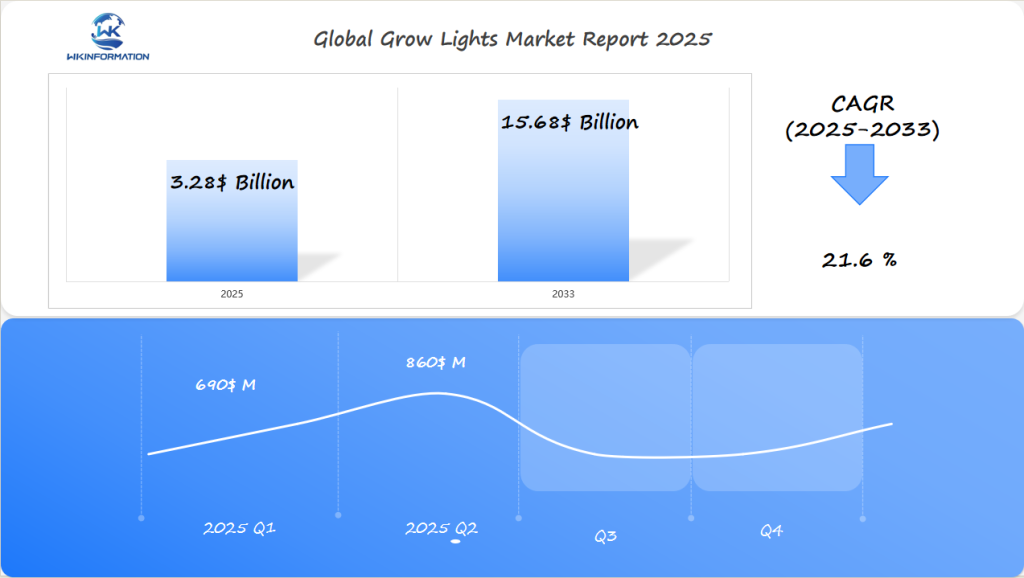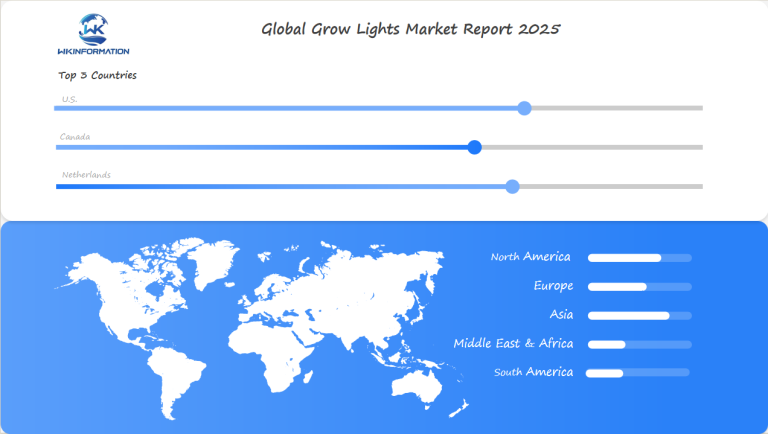Grow Lights Market Expected to Surpass $3.28 Billion Globally by 2025: Expansion Across the U.S., Canada, and the Netherlands
Discover the latest trends in the Grow Lights Market as it expands across North America. Rising demand in commercial agriculture and indoor farming drives substantial growth through 2025.
- Last Updated:
Grow Lights Market Q1 and Q2 2025 Performance Insights
The Grow Lights market is poised for dynamic expansion, expected to reach $3.28 billion by year-end 2025 with a robust CAGR of 21.6% from 2025 to 2033. Forecasts suggest the market will generate around $690 million in Q1 and $860 million in Q2. The stronger Q2 performance is closely tied to planting schedules, greenhouse expansions, and the intensified adoption of vertical farming techniques during the spring and early summer months.
The United States, Canada, and the Netherlands are emerging as the leading markets. The U.S. is seeing widespread implementation of controlled-environment agriculture technologies, driven by food security initiatives and demand for local produce. In Canada, government grants and sustainable farming incentives are fueling market momentum. Meanwhile, the Netherlands, already a global leader in agricultural innovation, continues to expand high-tech farming systems, positioning it as a trendsetter in grow light technology adoption.

Key Takeaways
- Global projected to reach $3.28 billion by 2025
- Indoor farming driving significant market expansion
- Technological innovations transforming agricultural lighting solutions
- United States, Canada, and Netherlands emerging as market leaders
- Increased focus on sustainable cultivation techniques
The Grow Lights Industry Chain: Opportunities Across Upstream and Downstream
The LED grow lights industry is complex and full of opportunities. It connects many sectors, from raw materials to end-users. This network is all about innovation and technology.
Key parts of the supply chain include:
- Raw material procurement for LED components
- Advanced semiconductor manufacturing
- Specialized LED grow light design and engineering
- Agricultural technology integration
- Distribution and retail channels
Upstream Opportunities: Focus on New Technologies
Upstream, the focus is on new technologies. Manufacturers are making LEDs that use less energy and help plants grow better. Innovative material science is key in creating these advanced lights.
Downstream Opportunities: Growth in Indoor Agriculture
Downstream, there are many chances for growth. Vertical farming, greenhouses, and indoor growing are all expanding. Studies show LED grow lights can boost crop yields and cut energy use.
Investing in better supply chains is changing the grow lights world. Companies that mix new tech with farming knowledge will likely lead the market.
Future Trends Fueling Innovation in Grow Lights
The grow lights industry is changing fast thanks to new tech. Smart grow lights are making indoor farming better by using advanced tech. They help plants grow well and use less energy.
Some big changes in grow light tech include:
- IoT-enabled smart grow lights with real-time monitoring
- Advanced spectral tuning for better plant growth
- Energy-saving designs to cut costs
The Importance of Spectral Tuning
Spectral tuning is a big step forward in growing plants. These smart lights can change light colors to help plants grow faster and better.
The Role of AI in Smart Grow Lights
Scientists are working on smart grow lights that use AI. These systems create special light plans for plants. They look at how plants react and adjust the light to get the best results.
Energy Efficiency in Grow Lights
Now, grow lights use less power but work better. This makes indoor farming more green and affordable.
The Road Ahead for Smart Grow Lights
Smart grow lights will keep getting better. They will use more AI, sensors, and data to create the best growing spaces for crops all over the world.
What's Constraining the Grow Lights Market? Insights into Challenges
The grow lights market is facing big challenges that slow its growth. Growers and farmers find it hard to use new lighting for plants. This is because of many obstacles.
High Costs
High costs are a big problem. Top-notch grow light systems are pricey. They need a lot of money to start. Costs include:
- High-quality LED lighting equipment
- Advanced control systems
- Energy infrastructure modifications
- Specialized installation services
Knowledge Gap
Knowing how to use these lights is also tough. It takes a lot of knowledge about:
- Spectral light needs for different plants
- Light intensity control
- Energy saving
- Temperature and humidity control
People working in agriculture need to learn a lot. The learning curve can be steep for traditional farmers transitioning to advanced cultivation methods.
Regulatory Issues
Rules and standards are also a problem. Different places have different rules for grow lights. This makes it hard for them to be used everywhere.

Global Geopolitics: A Game Changer for the Grow Lights Industry
The grow lights industry is at a key point where international trade and global politics meet. Recent changes in global rules have changed how makers and sellers deal with the complex world of farm tech.
Important global factors affecting the grow lights market include:
- Trade tariffs affecting international supply chains
- Regulatory changes in technology transfer
- Strategic investments in agricultural innovation
Nations are seeing the big deal about controlled environment farming. The global supply chain for grow lights is very sensitive to global tensions. This makes companies work harder to find reliable sources.
New markets are changing how grow lights are traded around the world. Countries like China, the United States, and Netherlands are becoming big players. They do this through smart rules and tech investments.
Companies need to think about global risks when planning for the future. Being able to change quickly and build local supply chains is key to winning in the fast-changing grow lights market.
Type-Wise Growth Outlook for the Grow Lights Market
The grow lights market is changing fast, thanks to new technologies. LED grow lights are leading the way, bringing big changes to indoor farming.
Each grow light type has its own special features:
- LED grow lights use less energy and can control light spectrum well
- HID grow lights work great in traditional greenhouses
- Fluorescent grow lights are affordable for small farms
New tech is always coming, and LED grow lights are at the forefront. They show great promise for farming and growing plants in a green way.
Applications of Grow Lights: Expanding Frontiers and New Niches
The world of grow lights is changing fast. It’s making farming and research better with new tech. Vertical farming is leading this change. It lets us grow food in cities in a greenway.
Grow lights are used in many ways:
- Vertical farming systems
- Greenhouse cultivation techniques
- Advanced research facilities
- Indoor agricultural laboratories
- Controlled environment agriculture
The Role of Research Facilities
Research places are key for grow light tech. Scientists use these lights to control plant growth. They can change the light’s color and strength for amazing research.
Benefits for Greenhouse Farming
Greenhouse farming gets better with new grow light tech. Farmers can grow crops longer and better. These lights give them control over how plants grow.
Global Footprint of the Grow Lights Market: Regional Perspectives
The grow lights market is a key area of technology across the world. Each area has its own special features and growth paths for new lighting for farming.
Looking at different parts of the world, we see different ways of using and improving grow lights:
- North America: Fast tech progress and early adoption
- Europe: Big on green farming and saving energy
- Asia-Pacific: Growing fast with new opportunities
North America: Leading in Vertical Farming and Controlled Environments
In North America, vertical farming and controlled environments lead to big investments in grow lights. Companies are working on new LED tech to help plants grow better.
Europe: Focused on Energy Efficiency in Greenhouses
The European market is all about saving energy, with the Netherlands and Germany leading in greenhouses. They keep improving grow light systems for farming.
Asia-Pacific: Rapid Growth Driven by Urban Farming and Food Safety Needs
Asia-Pacific is growing fast, with China and Japan leading in farm tech. Urban farming and food safety needs are pushing grow lights use in many areas.
As tech gets better in these areas, grow lights look set for a bright future. Ongoing research and development will keep growing the market globally.

U.S. Grow Lights Market in Focus: Emerging Patterns
The U.S. grow lights market is changing fast. New technologies and farming methods are leading the way. Cannabis and urban farming are driving the need for better lighting.
Urban Farming: A Shift in Food Production
Urban farming is changing how we grow food in cities. Places like New York, San Francisco, and Chicago are seeing more vertical farming. This uses advanced grow light systems.
- LED grow lights are becoming the preferred technology
- Smart lighting systems with precision spectrum control
- Energy-efficient solutions reducing operational costs
Cannabis Cultivation: A Growing Influence
Cannabis cultivation is a big part of the market now. States where cannabis is legal are seeing a lot of growth. This growth is in lighting technologies that help plants grow better.
The U.S. grow lights market is set to see a lot of investment in research. Companies are working on lighting that can be used in many ways. This includes small gardens and big cannabis farms.
- Increasing adoption of spectral tuning technologies
- Integration of AI and machine learning in grow light systems
- Sustainable and eco-friendly lighting solutions
New tech is making the U.S. grow lights market smarter and more efficient. These changes will help make farming better in the future.
Canada's Role in the Global Grow Lights Boom
Canada is a key player in the global grow lights market. It’s known for its strong greenhouse industry and leading role in cannabis production. This has made Canada a leader in agricultural lighting technology.
What Drives Canada’s Grow Lights Market?
The following factors contribute to the growth of Canada’s grow lights market:
- Expansive greenhouse industry supporting year-round crop production
- Legalized cannabis production creating massive lighting infrastructure demands
- Advanced technological investments in agricultural lighting solutions
The cannabis sector has boosted grow lights adoption in Canada. Indoor cannabis growing needs precise lighting. This lighting helps plants grow better and produce more.
Canadian makers are creating top-notch grow light tech. They focus on precision engineering and green design. This is how Canada shines in agricultural lighting.
Netherlands: A Growing Hub for the Grow Lights Market
The Netherlands is leading the way in Dutch horticulture. They are using innovative technologies to change the global grow lights market. With years of farming knowledge, Dutch companies are top in lighting for growing plants indoors.
What makes the Netherlands strong in grow light tech includes:
- Cutting-edge research and development in horticultural lighting
- Strategic partnerships with international technology firms
- Extensive greenhouse infrastructure supporting rapid innovation
- Global reputation for agricultural technological excellence
Dutch scientists have made advanced LED tech for better plant growth. Precision lighting systems help growers get the most out of plants. This means using less energy and growing more crops.
Working with others around the world has helped the Netherlands grow its market. Dutch companies team up with research groups and tech makers. Together, they create smart lighting for different farming needs.
The Dutch mix science with practical engineering. This makes them key in the grow lights market. Their focus on green, effective farming tech keeps them influential in this growing field.
The Future of Grow Lights: Growth Drivers and Predictions
The grow lights market is set for big changes. New technologies and a focus on sustainability are leading the way. LED advancements and smart lighting are changing how we grow crops, making it more efficient and precise.
Growth Drivers
Several factors are pushing this growth:
- LED grow lights that use less energy
- Advanced spectral control for precision agriculture
- Vertical farming growing in cities
- More demand for crops all year round
Predictions
Experts predict a big increase in the market. They say we’ll see more:
- Smart grow light systems with AI for monitoring
- Green lighting options that cut down on carbon
- Custom spectrum tech for different plant stages
Sustainability trends are shaping grow light development. Makers are focusing on designs that save energy and boost crop yields. Using renewable energy with grow lights is seen as a key innovation.
New markets in North America and Europe will lead to big tech leaps. This opens doors for companies and researchers to improve grow light tech.
Competitive Battleground: Key Players in the Grow Lights Industry
The grow lights market is growing fast, with many companies competing. It’s important for businesses to find their place in this market. They need to stand out to get a big share.
Some companies are leading the way with new strategies:
- Philips Lighting (Signify) leads with its advanced LED grow lights
- Osram Licht AG offers precise horticultural lighting
- General Electric Company brings new spectral optimization technologies
New companies are also making waves. They focus on specific areas like vertical farming. This helps them stand out from the big names.
Now, companies focus on being different with their technology. They also look for ways to be more sustainable. And they make products that can change with the market.
The grow lights market is changing fast. Leaders and new players will keep pushing the limits of technology. This will lead to new ways to light up agriculture.
Overall
| Report Metric | Details |
|---|---|
| Report Name | Global Grow Lights Market Report |
| Base Year | 2024 |
| Segment by Type |
· LED Grow Lights · HID Grow Lights · Fluorescent Grow Lights |
| Segment by Application |
· Vertical Farming · Greenhouse Cultivation · Others |
| Geographies Covered |
· North America (United States, Canada) · Europe (Germany, France, UK, Italy, Russia) · Asia-Pacific (China, Japan, South Korea, Taiwan) · Southeast Asia (India) · Latin America (Mexico, Brazil) |
| Forecast units | USD million in value |
| Report coverage | Revenue and volume forecast, company share, competitive landscape, growth factors and trends |
The grow lights market is full of chances for smart investors and entrepreneurs. It’s expected to grow a lot, thanks to new tech in farming and gardening. Places like the United States, Canada, and the Netherlands are especially good for growing businesses.
But, there are risks to watch out for. Changes in laws, shifting energy prices, and more competition are big challenges. Investors need to think about how well their tech can adapt and how they’ll get into new markets.
The global grow lights market is a big chance for companies ready to use new farming tech. To succeed, you need to know about the latest tech, understand different markets, and be creative. Businesses that mix new tech with practical use will likely grow the most.
Global Grow Lights Market Report (Can Read by Free sample) – Table of Contents
Chapter 1: Grow Lights Market Analysis Overview
- Competitive Forces Analysis (Porter’s Five Forces)
- Strategic Growth Assessment (Ansoff Matrix)
- Industry Value Chain Insights
- Regional Trends and Key Market Drivers
- Grow Lights Market Segmentation Overview
Chapter 2: Competitive Landscape
- Global Grow Lights Players and Regional Insights
- Key Players and Market Share Analysis
- Sales Trends of Leading Companies
- Year-on-Year Performance Insights
- Competitive Strategies and Market Positioning
- Key Differentiators and Strategic Moves
Chapter 3: Grow Lights Market Segmentation Analysis
- Key Data and Visual Insights
- Trends, Growth Rates, and Drivers
- Segment Dynamics and Insights
- Detailed Market Analysis by Segment
Chapter 4: Regional Market Performance
- Consumer Trends by Region
- Historical Data and Growth Forecasts
- Regional Growth Factors
- Economic, Demographic, and Technological Impacts
- Challenges and Opportunities in Key Regions
- Regional Trends and Market Shifts
- Key Cities and High-Demand Areas
Chapter 5: Grow Lights Emerging and Untapped Markets
- Growth Potential in Secondary Regions
- Trends, Challenges, and Opportunities
Chapter 6: Product and Application Segmentation
- Product Types and Innovation Trends
- Application-Based Market Insights
Chapter 7: Grow Lights Consumer Insights
- Demographics and Buying Behaviors
- TargetAudience Profiles
Chapter 8: Key Findings and Recommendations
- Summary of Grow Lights Market Insights
- Actionable Recommendations for Stakeholders

Access the study in MULTIPLEFORMATS
Didn’t find what you’re looking for?
TALK TO OUR ANALYST TEAM
Need something within your budget?
NO WORRIES! WE GOT YOU COVERED!
Call us on: +1-866-739-3133
Email: infor@wkinformation.com
What is the projected market value for grow lights by 2025?
The global grow lights market is expected to hit $3.28 billion by 2025. This growth is driven by the rise of indoor farming and commercial agriculture. The United States, Canada, and the Netherlands are leading this trend.
What are the primary types of grow lights available in the market?
Grow lights come in three main types: LED, HID, and fluorescent. Each has its own benefits and is used in different ways. LED lights are seen as the most innovative and promising.
How are smart technologies impacting grow light development?
Smart grow lights are getting better with IoT and spectral tuning. These advancements let farmers control light spectrum, intensity, and duration. This helps in optimizing plant growth.
What are the main challenges in the grow lights market?
Challenges include high costs and the need for technical knowledge. There are also regulatory hurdles and the complexity of using advanced technologies in agriculture.
Which industries are adopting grow light technologies?
Grow lights are used in vertical farming, greenhouses, research, commercial agriculture, cannabis production, and urban farming. They are adopted across many sectors.
How are geopolitical factors affecting the grow lights industry?
Trade policies, regulations, and supply chain disruptions affect the market. Companies must adapt and find new ways to source and manufacture.
Which regions are leading in grow light technology?
North America, Canada, and the Netherlands are at the forefront. They invest heavily in research and development of agricultural solutions.
What drives innovation in grow light technologies?
Innovation in grow light technologies is driven by several factors:
- Energy efficiency: Finding ways to use less energy while still providing optimal lighting for plant growth.
- Spectral tuning: Developing lights that can emit specific wavelengths of light to enhance photosynthesis and plant development.
- IoT (Internet of Things): Integrating smart technology into grow lights for remote monitoring and control.
- Sustainability: Creating environmentally friendly lighting solutions that reduce carbon footprint.
- Year-round crops: Meeting the demand for continuous crop production regardless of seasonal limitations.
These factors play a crucial role in pushing the industry forward and shaping the future of indoor farming.
Are grow lights energy-efficient?
Yes, modern grow lights, especially LEDs, are very energy-efficient. They use less power and provide the right light for plants, saving costs.
What role does the Netherlands play in grow light development?
The Netherlands is a key player in horticulture technology. It leads in developing new grow light solutions and stays ahead through research and collaborations.


